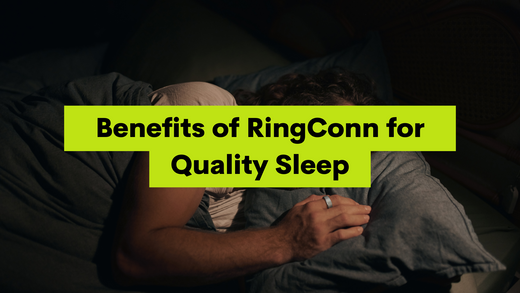
Benefits of RingConn for Quality Sleep
“What is a RingConn?” Well, it's a smart ring designed to track your activities, daily habits, and sleep. Impressive right? While the RingConn is abundant in its capabilities, as is evident in this introduction, we are here to discuss just one in particular. Sleep tracking.
Have you ever had trouble sleeping and wondered why? Or maybe you’re just curious and would love to know more about what goes on during your periods of slumber. Well, boy have you stumbled upon the most perfect part of the internet. Designed with comfort, elegance and efficiency in mind, the RingConn smart ring might just be the solution for all you troubled sleepers. “How could the RingConn possibly help me sleep better?” A valid question. Let’s talk about it.
Firstly, let's discuss the positively absurd level of accuracy this device possesses. While sleep tracking, with RingConn’s very own, no-subscriptions-needed, mobile application “RingConn”. The device records and displays data down to the movements you make in your sleep. The most bizarre part about the RingConn is, it even records your naps. Unprompted. Mind blown yet? Mine is.
Now that we’ve established RingConn’s accuracy, let’s dive into the more data-rich part of RingConn’s sleep tracking. The way this smart device records and presents your sleep data and overall sleep quality is by something called “Sleep Score”. Your sleep score ranges from 0-100. Just like most exams you've taken, the higher the score, the better the result. Here is where it gets pretty data-heavy. You see, in order to come up with this “Sleep Score”, your RingConn will have to record and compile a few sets of separate data concerning your sleep status.
These separate data sets include:
- Sleep Efficiency
- Sleep Stages & Time Asleep
- Sleeping Heart Rate [bpm & HRV]
- Blood Oxygen Saturation [SpO2]
- Sleeping Skin Temperature
“Thorough” may be far too simple of a word to describe RingConn’s sleep data-gathering process.
Sleep Efficiency
Your sleep efficiency is determined by the total time you spend asleep and the total time you spend in bed.


Sleep Stages & Time Asleep
Your sleep stages are determined by your brain waves. Typically, when we are asleep, we cycle through different sleep stages.
These stages are as follows:
- Awake
- Rapid Eye Movement [REM]
- Light Sleep
- Deep Sleep

The total time of all the sleep stages you experience during sleep, excluding the awake stage, will be calculated to determine your total time asleep. “Why do I feel so tired even after just waking up?” Maybe taking a look at your “Sleep Stages” data might give you a little insight.
Sleeping Heart Rate
Beats Per Minute [bpm]:
According to RingConn “A sleep standard heart rate between 55-65 bpm indicates healthy cardiac function and low load” It is also stated that “a sleep standard heart rate greater than 70 bpm indicates a high cardiac load.”
“What does high and low cardiac load mean?” Good question. High cardiac load indicates that your heart is working harder than usual, which could be caused by factors such as high blood pressure or increased physical activity. Contrarily, low cardiac load indicates that the heart is under little stress, perhaps due to a resting state or very low blood pressure, a cause for concern.

Heart rate Variability [HRV]:
Before anyone asks, HRV is the variation in time between consecutive heartbeats. This means the time it takes for another heartbeat to occur after the last one. “How is this relevant to sleep tracking?” Well, the tracking of HRV provides a direct indication of how much stress your body is under. Usually, when under stress, your heart rate rises and beats at a more consistent rhythm, hence, causing your HRV to be lower. Therefore, the higher the HRV, the lower the stress. How is HRV relevant to sleep tracking? The same way bpm is. It highlights cardiovascular stress being placed on an individual. The lesser the stress, the more relaxed one is. What’s more relaxing than sleep?

Blood Oxygen Saturation [SpO2]
Blood Oxygen Saturation [SpO2] measures the levels of haemoglobin [a protein in red blood cells that carries oxygen] in the blood. Normal levels usually range between 95% and 100%.

Its importance in sleep tracking is quite significant. Low SpO2 levels could point out abnormalities suggesting the presence of underlying conditions such as allergies. Monitoring oxygen saturation levels during states of slumber can help detect such issues and lead to improvements in factors such as sleep environment.
Sleeping Skin Temperature
The RingConn presents your sleeping skin temperature data in 3 different ways, using the terms “Average”, “Baseline” and “Offset”. The “Average” determines your overall sleeping skin temperature by measuring the average temperature of the finger your RingConn is on, during sleep. The “Baseline” indicates your average sleeping skin temperature for the past 30 days. As for the “Offset”, it calculates irregularities between your sleeping skin temperature for the night and your baseline temperature.

If the data recorded dictates sudden abnormalities in your skin temperature, perhaps a quick adjustment to your surroundings, such as turning the air conditioning on or off, might help contribute to a much more comfortable and restful sleep.
Do take note, however, skin temperature and body temperature do not go hand in hand. With skin temperature, numbers vary from body part to body part while the opposite applies to body temperature.
So, now you have all this information about sleep data, perhaps we should revisit the initial question of “How could the RingConn possibly help me sleep better?”. Let’s work this out together. Before the RingConn, you were completely in the dark when it came to why you were having trouble sleeping. Lacking that crucial answer to your “Why?” meant that actions could not be taken to directly tackle the “how?” when it came to improving certain sleep habits. RingConn’s sleep-tracking abilities answer that age-old “Why?”
Also, don't you worry! While trying to improve your sleep, you will not have to subject yourself to the amount of data presented above. The RingConn app summarises your sleep data for you.

So what do you say? Ready to catch some ZZZZZZzzzzzzzsssssss with RingConn?
Author: Nazera Latif



Leave a comment